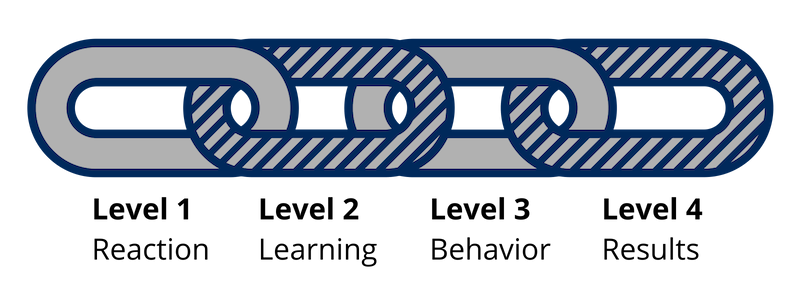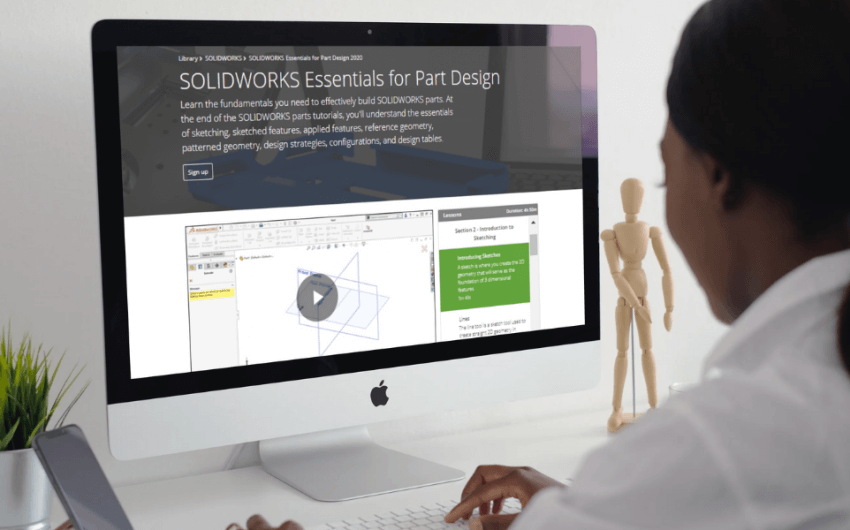How to Use the Kirkpatrick Model: Training Evaluation Question Examples for Engineering Teams
Ask the Right Questions with These Training Evaluation Examples for Engineering Managers
The Kirkpatrick Model has been implemented across many industries including aerospace, government, high-tech, and even engineering. No matter how large or small or unique your business is, the Kirkpatrick Model is a useful tool for your learning and development initiatives. In this article, we’ll give you an overview of the Kirkpatrick Model and how it can be used specifically for engineering teams.
What is the Kirkpatrick Model?
The Kirkpatrick Model is widely recognized as a leading method for evaluating training effectiveness. It is comprised of four levels: Reaction, Learning, Behavior, and Results. As the diagram indicates, these four stages all work together to help you deliver a rewarding training program for your employees.

The Kirkpatrick Model
The Kirkpatrick Model offers guidance on how to measure training effectiveness at each level. One of the most common ways to implement this evaluation method is by asking questions to collect employee feedback, whether via an informal discussion or a formal training evaluation questionnaire. To make it simple, we’ve put together a list of example questions you can use at each level to easily collect the data you need about your training program effectiveness. At SolidProfessor, we’re focused on helping engineering design teams improve their software skills, so the questions will be written as examples for engineering managers to use. But with a few tweaks, anyone can use them to evaluate their training programs. We’ll also go over what each level entails!
Kirkpatrick Level 1 Evaluation Examples: Reaction
Level 1 evaluates how satisfied and engaged employees are with their training, and how relevant they feel it is to their roles. Here’s how an engineering manager can ask their employees these questions to gauge their reaction to the training:
- Were you satisfied with the CAD and CAM training overall?
- Was the training an effective use of your time? Was it disruptive or did it work in tandem with your current projects?
- Did the courses cover enough material? Were they at the right software skill level, or too easy/advanced?
- Did the training address the needs in your role and on your engineering team?
- Did the training style work for you? Consider pace, delivery method, location (in-person or online), content, etc.
- Did the training motivate you to pursue more CAD and CAM training?
- Would you recommend this kind of engineering training to others?
Read Next: How to Get Ahead with Skills Gap Assessments in Engineering Design >>
Kirkpatrick Level 2 Evaluation Examples: Learning
Level 2 measures how well participants were able to learn based on knowledge, skill, attitude, confidence, and commitment gained. This stage will involve some other evaluation methods to be the most effective (e.g., quizzes and tests). Ask questions like these to understand how well your engineers have learned the given material:
- Do you think you’ve gained the design skills you needed to learn?
- How would you rate your knowledge on these modeling techniques from 1-10?
- Are there any topics from the training you still don’t understand?
- Do you feel as though you can apply what you learned to your work?
- What is the biggest change you’ve noticed in your work so far with these new skills?
- Did anything noticeably hinder or promote your ability to learn during the training?
- Does our organization’s culture contribute to your ability to learn?
- Are there any CAD or CAM topics you would like to pursue learning further?
Evaluate SOLIDWORKS Skills Online: Try our free SOLIDWORKS skills gap assessments to see. how your CAD skills stack up>>
Kirkpatrick Level 3 Evaluation Examples: Behavior
Level 3 looks at the practical side of training evaluation, examining how well participants can apply what they learned in training to their jobs. The New World Kirkpatrick Model states that encouragement and incentives from leadership are required for success in this stage. Use the following questions to understand your team’s behavior post-training:
- Are you using what you learned in training in your daily design work?
- Are there noticeable changes in individual and team performance post-training? Think: Using more updated techniques and shortcuts, spending less time calling tech support for simple how-to design questions, etc.
- Think back to prior training. How are you performing in your role now compared to after previous training sessions?
- Are there any obstacles or bottlenecks preventing you from using your new skills efficiently?
- Have you felt supported and motivated to use the new skills you’ve learned? What can leadership do to promote this?
- Is there anything you need in the work environment to help you use what you’ve learned?
Get the Ultimate Effective Training Plan for SOLIDWORKS: Live and On-demand Training Bundles from SolidProfessor and Hawk Ridge Systems >>
Kirkpatrick Level 4 Evaluation Examples: Results
Level 4 is where you examine the ROI of your training. This level looks at how well you’ve reached the goals you set out to accomplish through training. Level 4 evaluation examples are tricky because they rely on performance indicators, which will be likely unique to your engineering team. However, here are a few ideas for capturing feedback on CAD/CAM training results:
- Do you feel that the team has performed better since training? Which design skills have improved the most?
- Are we making fewer errors and getting projects done more quickly and efficiently? Think: Hitting product design deadlines more easily, fewer ECOs, better communication with manufacturers downstream, etc.
- Have we reduced any software skill gaps on our team? (Hint: this can be measured with pre- and post-training skills gap assessments!)
- Are our customers/clients pleased with our improvements?
- To what extent has the training helped our team reach our goals?
- Has the training helped you work toward and/or achieve any professional development goals?
These example questions will help you stay on track when using the Kirkpatrick Model to determine training effectiveness. There are many different tools you can use to help apply the model and ask these questions, but it’s important to collect your feedback data in a way that will inform your training decisions. Our free Ebook, Tools and Techniques for the Kirkpatrick Model That Work, can help you decide which evaluation strategies will work best for your engineering team! Download it for free below.

























